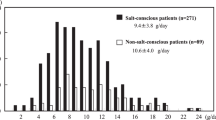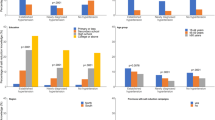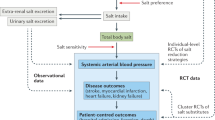Abstract
Salt reduction is the most important lifestyle modification, especially in Japanese individuals who still consume a significant amount of salt. The Dietary Reference Intakes for Japanese 2020, issued by the Ministry of Health, Labour and Welfare, propose a salt intake goal of <7.5 g/day for men and <6.5 g/day for women. Regarding the goal of salt reduction in hypertensive patients, the hypertension guideline by the Japanese Society of Hypertension 2019 (JSH2019) proposes a goal of <6 g/day. Although the average salt intake in Japan gradually decreased in the early 2000s, the declining trend has not been seen in recent years, and thus, it seems difficult to achieve these target salt intake levels. To overcome this challenge, the JSH announced the ‘JSH Tokyo Declaration’ and pledged to create a specific action plan to achieve the target salt intake level of <6 g/day. The six strategies to achieve the target salt intake level are as follows: (1) educating citizens on the harms of excessive salt intake and the importance of reducing salt intake; (2) recommending the assessment of the salt intake of individuals or populations and proposing adequate methods to reduce salt intake; (3) promoting salt reduction for children as a part of dietary education at school; (4) promoting salt reduction in takeout food, prepared dishes, canteens, and school lunches; (5) encouraging companies to develop and promote low-salt foods; and (6) encouraging the government to take measures to promote salt reduction. Through these activities, a society with a low salt intake will be expected in the near future.
This is a preview of subscription content, access via your institution
Access options
Subscribe to this journal
Receive 12 print issues and online access
$259.00 per year
only $21.58 per issue
Buy this article
- Purchase on Springer Link
- Instant access to full article PDF
Prices may be subject to local taxes which are calculated during checkout





Similar content being viewed by others
References
INTERSALT Cooperative Research Group. Intersalt: an international study of electrolyte excretion and blood pressure. Results for 24 h urinary sodium and potassium excretion. BMJ. 1988;297:319–28.
Mozaffarian D, Fahimi S, Singh GM, Micha R, Khatibzadeh S.Engell RE, Global Burden of Diseases Nutrition and Chronic Diseases Expert Group et al. Global sodium consumption and death from cardiovascular causes. N Engl J Med. 2014;371:624–34.
He FJ, Macgregor GA. A comprehensive review on salt and health and current experience of worldwide salt reduction programmes. J Hum Hypertens. 2009;23:363–84.
Ikeda N, Saito E, Kondo N, Inoue M, Ikeda S, Satoh T, et al. What has made the population of Japan healthy? Lancet. 2011;378:1094–105.
Tomonari T, Fukuda M, Miura T, Mizuno M, Wakamatsu T, Ichikawa T, et al. Is salt intake an independent risk factor of stroke mortality? Demographic analysis by regions in Japan. J Am Soc Hypertens. 2011;5:456–62.
Shikata K, KiyoharaY, Kubo M, Yonemoto K, NinomiyaT, Shirota T, et al. A prospective study of dietary salt intake and gastric cancer incidence in a defined Japanese population: the Hisayama study. Int J Cancer. 2006;119:196–201.
Ma Y, He FJ, Sun Q, Yuan C, Kieneker LM, Curhan GC, et al. 24-hour sodium and potassium excretion and cardiovascular risk. N Eng J Med. 2021. https://doi.org/10.1056/NEJMoa2109794.
Poorolajal J, Zeraati F, Soltanian AR, Sheikh V, Hooshmand E, Maleki A, et al. Oral potassium supplementation for management of essential hypertension: a meta-analysis of randomized controlled trials. PLoS One. 2017;12:e0174967.
Vinceti M, Filippini T, Crippa A, de Sesmaisons A, Wise LA, Orsini N. Meta-analysis of potassium intake and the risk of stroke. J Am Heart Assoc. 2016;5:e004210.
Kogure M, Nakaya N, Hirata T, Tsuchiya N, Nakamura T, Narita A, et al. Sodium/potassium ratio change was associated with blood pressure change: possibility of population approach for sodium/potassium ratio reduction in health checkup. Hypertens Res. 2021;44:225–31.
Okayama A, Okuda N, Miura K, Okamura T, Hayakawa T, Akasaka H, et al. Dietary sodium-to-potassium ratio as a risk factor for stroke, cardiovascular disease and all-cause mortality in Japan: the NIPPON DATA80 cohort study. BMJ Open. 2016;6:e011632. https://doi.org/10.1136/bmjopen-2016-011632.
The Ministry of Health, Labour and Welfare. The National Health and Nutrition Survey in Japan, 2019. https://www.mhlw.go.jp/content/000711003.pdf. (in Japanese)
Oniki H, Tsuchihashi T, Sakaki M, Arakawa K. Trends in salt intake in hypertensive patients and the effectiveness of guidance on salt reduction. J Blood Press. 2013;20:626–9. (in Japanese)
The Japanese Society of Hypertension. Guidelines for the Management of Hypertension 2019 (JSH2019). Tokyo, Japan: Life Science Publishing Co., Ltd.; 2019.
Graudal N, Hubeck-Graudal T, Jurgens G, McCarron DA. The significance of duration and amount of sodium reduction intervention in normotensive and hypertensive individuals: a meta-analysis. Adv Nutr. 2015;6:169–77.
He FJ, Li J, MacGregor GA. Effect of longer-term modest salt reductions on blood pressure. Cochrane Database Syst Rev. 2013;30:CD004937.
Aburto NJ, Ziolkovska A, Hooper L, Elliott P, Cappuccio FP, Meerpohl JJ. Effect of lower sodium intake on health: systematic review and meta-analyses. BMJ. 2013;346:f1326.
Lennon SL, DellaValle DM, Rodder SG, Prest M, Sinley RC, Hoy MK, et al. 2015 evidence analysis library evidence-based nutrition practice guideline for the management of hypertension in adults. J Acad Nutr Diet. 2017;117:1445–58.
Whelton PK, Carey RM, Aronow WS, Casey DE Jr, Collins KJ, Himmelfarb CD, et al. 2017 ACC/ AHA/ AAPA/ ABC/ ACPM/ AGS/ APhA/ ASH/ ASPC/ NMA/ PCNA guidelines for the prevention, detection, evaluation, and management of high blood pressure in adults: a report of the American College of Cardiology/American Heart Association Task Force on Clinical Practice Guidelines. Hypertension. 2018;71:e13–e115.
Williams B, Mancia G, Spiering W, Agabiti Rosei E, Azizi M, Burnier M, et al. ESC Scientific Document Group. 2018 ESC/ESH guidelines for the management of arterial hypertension. Eur Heart J. 2018;39:3021–104.
The Ministry of Health, Labour and Welfare. Tokyo, Japan; Dietary Reference Intakes for Japanese; 2020. (in Japanese)
WHO. Guideline: Sodium intake for adults and children. Geneva, Switzerland: World Health Organization (WHO); 2012.
National Institute of Health and Nutrition. Health Japan 21 (the second term) Analysis and Assessment Project. https://www.nibiohn.go.jp/eiken/kenkounippon21/en/kenkounippon21/mokuhyou.html.
Tsuchihashi T, Ishimitsu T, Ando K, Kusaka M, Ichihara A, Miura K, et al. JSH Statement: Tokyo declaration promoting salt reduction by the Japanese Society of Hypertension—the JSH Tokyo declaration. Hypertens Res. 2020; 43:1133–4. https://www.jpnsh.jp/declaration_tokyo2019.html.
Ohta Y, Tsuchihashi T, Ueno M, Kajioka T, Onaka U, Tominaga M, et al. Relationship between the awareness of salt restriction and the actual salt intake in hypertensive patients. Hypertens Res. 2004;27:243–6.
Tsuchihashi T, Kai H, Kusaka M, Kawamura M, Matsuura H, Miura K, et al. (3) Assessment and application of salt intake in the management of hypertension. The Salt Reduction Committee of the Japanese Society of Hypertension. Rep. Salt Reduct Comm Jpn Soc Hypertension. 2012;2012:39–50.
Tsuchihashi T, Masuda K, Oniki H, Sakaki M, Arakawa K, Kameda W, et al. Assessment of salt intake by using a simple check sheet in hypertensive patients. J Blood Press. 2013;20:1239–43. (in Japanese)
Kobayashi S, Murakami K, Sasaki S, Okubo H, Hirota N, Notsu A, et al. Comparison of relative validity of food group intakes estimated by comprehensive and brief-type self-administered diet history questionnaires against 16 d dietary records in Japanese adults. Public Health Nutr. 2011;14:1200–11.
Kobayashi S, Honda S, Murakami K, Sasaki S, Okubo H, Hirota N, et al. Both comprehensive and brief self-administered diet history questionnaires satisfactorily rank nutrient intakes in Japanese adults. J Epidemiol. 2012;22:151–9.
Sakata S, Tsuchihashi T, Ohta Y, Tominaga M, Arakawa K, Sakaki M, et al. Relationship between salt intake as estimated by a brief self-administered diet-history questionnaire (BDHQ) and 24-h urinary salt excretion in hypertensive patients. Hypertens Res. 2015;38:560–3.
Yasutake K, Miyoshi E, Kajiyama T, Umeki Y, Misumi Y, Horita N, et al. Comparison of a salt check sheet with 24-h urinary salt excretion measurement in local residents. Hypertens Res. 2016;39:879–85.
Yamasue K, Tochikubo O, Kono E, Maeda H. Self-monitoring of home blood pressure with estimation of daily salt intake using a new electrical device. J Hum Hypertens. 2006;20:593–8.
Ohta Y, Tsuchihashi T, Miyata E, Onaka U. Usefulness of self-monitoring of urinary salt excretion in hypertensive patients. Clin Exp Hypertens. 2009;31:690–7.
Takada T, Imamoto M, Sasaki S, Azuma T, Miyashita J, Hayashi M, et al. Effects of self-monitoring of daily salt intake estimated by a simple electrical device for salt reduction: a cluster randomized trial. Hypertens Res. 2018;41:524–30.
Kawasaki T, Itoh K, Uezono K, Sasaki H. A simple method for estimating 24 h urinary sodium and potassium excretion from second morning voiding urine specimen in adults. Clin Exp Pharm Physiol. 1993;20:7–14.
Tanaka T, Okamura T, Miura K, Kadowaki T, Ueshima H, Nakagawa H, et al. A simple method to estimate populational 24-h urinary sodium and potassium excretion using a casual urine specimen. J Hum Hypertens. 2002;16:97–103.
Kario K, Nomura A, Harada N, Okura A, Nakagawa K, Tanigawa T, et al. Efficacy of a digital therapeutics system in the management of essential hypertension: the HERB-DH1 pivotal trial. Eur Heart J. 2021;42:4111–22.
Morinaga Y, Tsuchihashi T, Ohta Y, Matsumura K. Salt intake in 3-year-old Japanese children. Hypertens Res. 2011;34:836–9.
Yasutake K, Nagafuchi M, Izu R, Kajiyama T, Imai K, Murata Y, et al. Sodium and potassium urinary excretion levels of preschool children: Individual, daily, and seasonal differences. Clin Exp Hypertens. 2017;19:577–83.
Ohta Y, Iwayama K, Suzuki H, Sakata S, Hayashi S, Iwashima Y, et al. Salt intake and eating habits of school-aged children. Hypertens Res. 2016;39:812–7.
Yasutake K, Nagafuchi M, Tanaka T, Fujii K, Tsuchihashi T, Ohe K, et al. Necessity of salt intake reduction education beginning in youth: a cross-sectional survey of sodium-to-potassium ratios in mothers and their preschool children. Hypertens Res. 2021;44:1307–15.
Takimoto H, Saito A, Htun NC, Abe K. Food items contributing to high dietary salt intake among Japanese adults in the 2012 National Health and Nutrition Survey. Hypertens Res. 2018;41:209–12.
Ohta Y, Tsuchihashi T, Onaka U, Miyata E. Long-term compliance of salt restriction and blood pressure control status in hypertensive outpatients. Clin Exp Hypertens. 2010;32:234–8.
The Japanese Society of Hypertension. Starting a Low Sodium Diet-Information from the Salt Reduction Committee to general public. http://jpnsh.jp/general_salt.html.
Neal B, Wu Y, Feng X, Zhang R, Zhang Y, Shi J, et al. Effect of salt substitution on cardiovascular events and death. N Engl J Med. 2021;385:1067–77.
The Ministry of Health, Labour and Welfare. Summary of the report of the committee meeting on the promotion of a healthy and sustainable food environment. https://www.mhlw.go.jp/content/10900000/000836945.pdf
Fang K, He Y, Fang Y, Lian Y. Dietary sodium intake and food sources among Chinese adults: data from the CNNHS 2010-2012. Nutrients. 2020;12:453. https://doi.org/10.3390/nu12020453.
Park HK, Lee Y, Kang BW, Kwon KI, Kim JW, Kwon OS, et al. Progress on sodium reduction in South Korea. BMJ Glob Health. 2020;5:e002028. https://doi.org/10.1136/bmjgh-2019-002028.
Joint Committee for Guideline Revision. 2018 Chinese guidelines for prevention and treatment of hypertension-A report of the Revision Committee of Chinese Guidelines for Prevention and Treatment of Hypertension. J Geriat Cardiol. 2019;16:182–241.
Lee HY, Shin J, Kim GH, Park S, Ihm SH, Kim HC, et al. 2018 Korean society of hypertension guidelines for the management of hypertension: part II-diagnosis and treatment of hypertension. Clin Hypertens. 2019;25:20. https://doi.org/10.1186/s40885-019-0124-x.
Author information
Authors and Affiliations
Corresponding author
Ethics declarations
Conflict of interest
The author declares no competing interests.
Additional information
Publisher’s note Springer Nature remains neutral with regard to jurisdictional claims in published maps and institutional affiliations.
Rights and permissions
About this article
Cite this article
Tsuchihashi, T. Dietary salt intake in Japan - past, present, and future. Hypertens Res 45, 748–757 (2022). https://doi.org/10.1038/s41440-022-00888-2
Received:
Revised:
Accepted:
Published:
Issue Date:
DOI: https://doi.org/10.1038/s41440-022-00888-2
Keywords
This article is cited by
-
Treatment of hypertension and obstructive sleep apnea counteracts cognitive decline in common neurocognitive disorders in diagnosis-related patterns
Scientific Reports (2023)
-
Nephrons, podocytes and chronic kidney disease: Strategic antihypertensive therapy for renoprotection
Hypertension Research (2023)
-
Lifetime home BP-centered approach is the core from onset to aggravation of hypertension
Hypertension Research (2023)
-
Achievement rate of target blood pressure in patients with hypertension treated by hypertension specialists and non-specialists in a real-world setting
Hypertension Research (2023)
-
Old story, new twist: reducing salt and increasing potassium intake as a social issue according to the INTERMAP Japan
Hypertension Research (2023)



